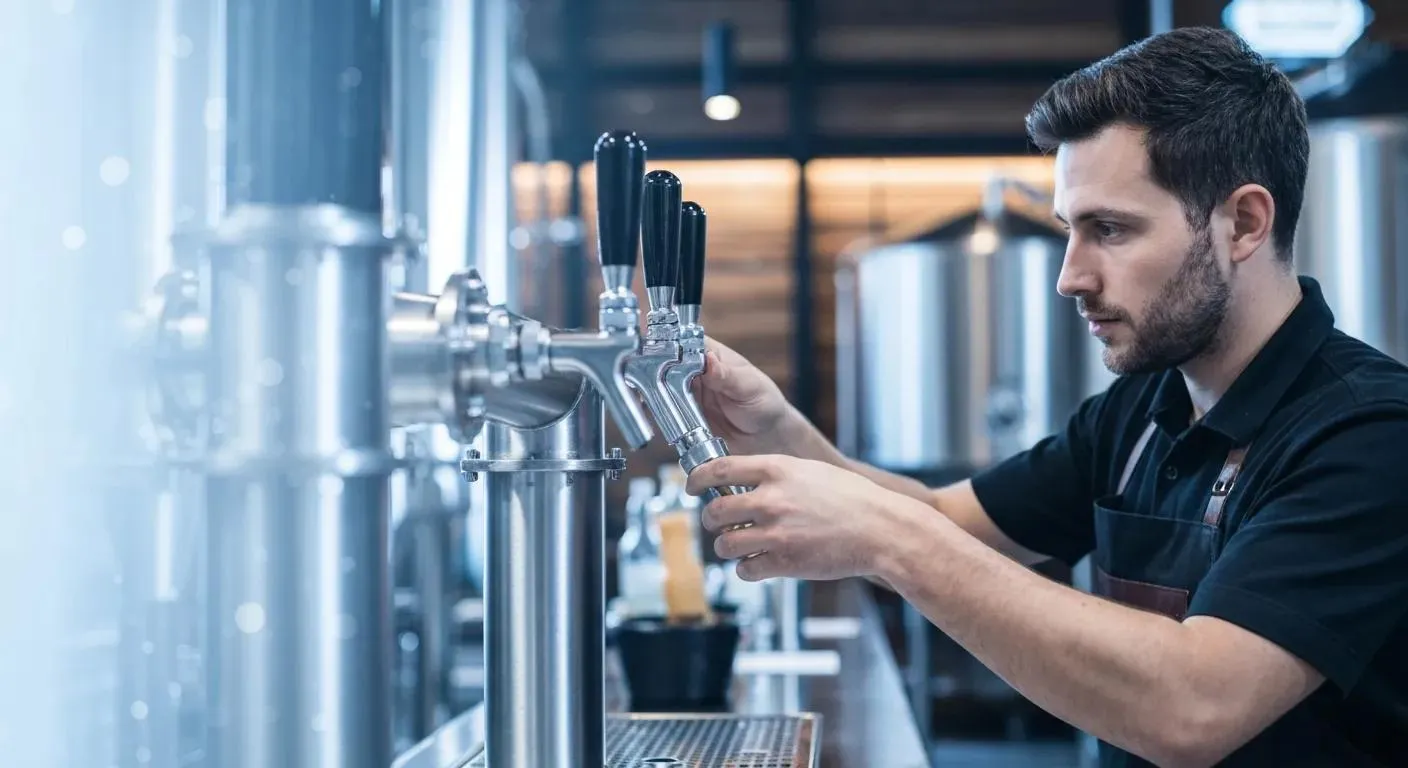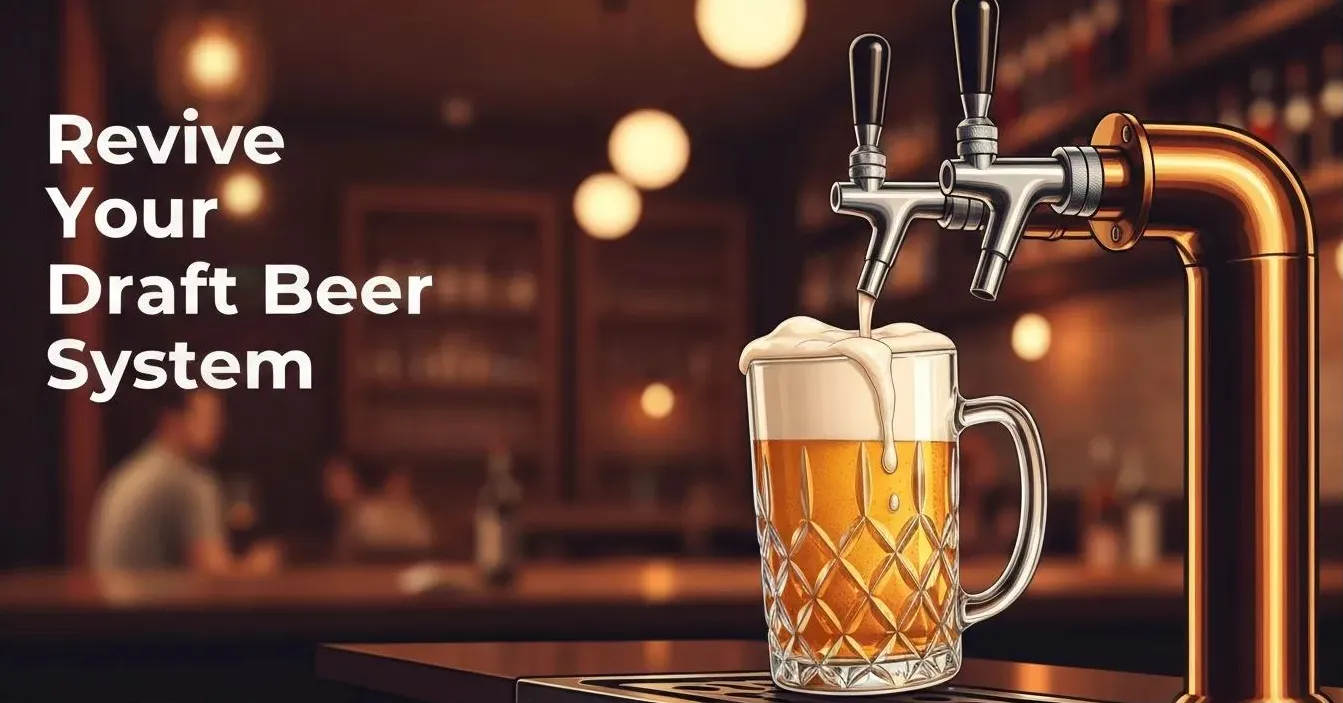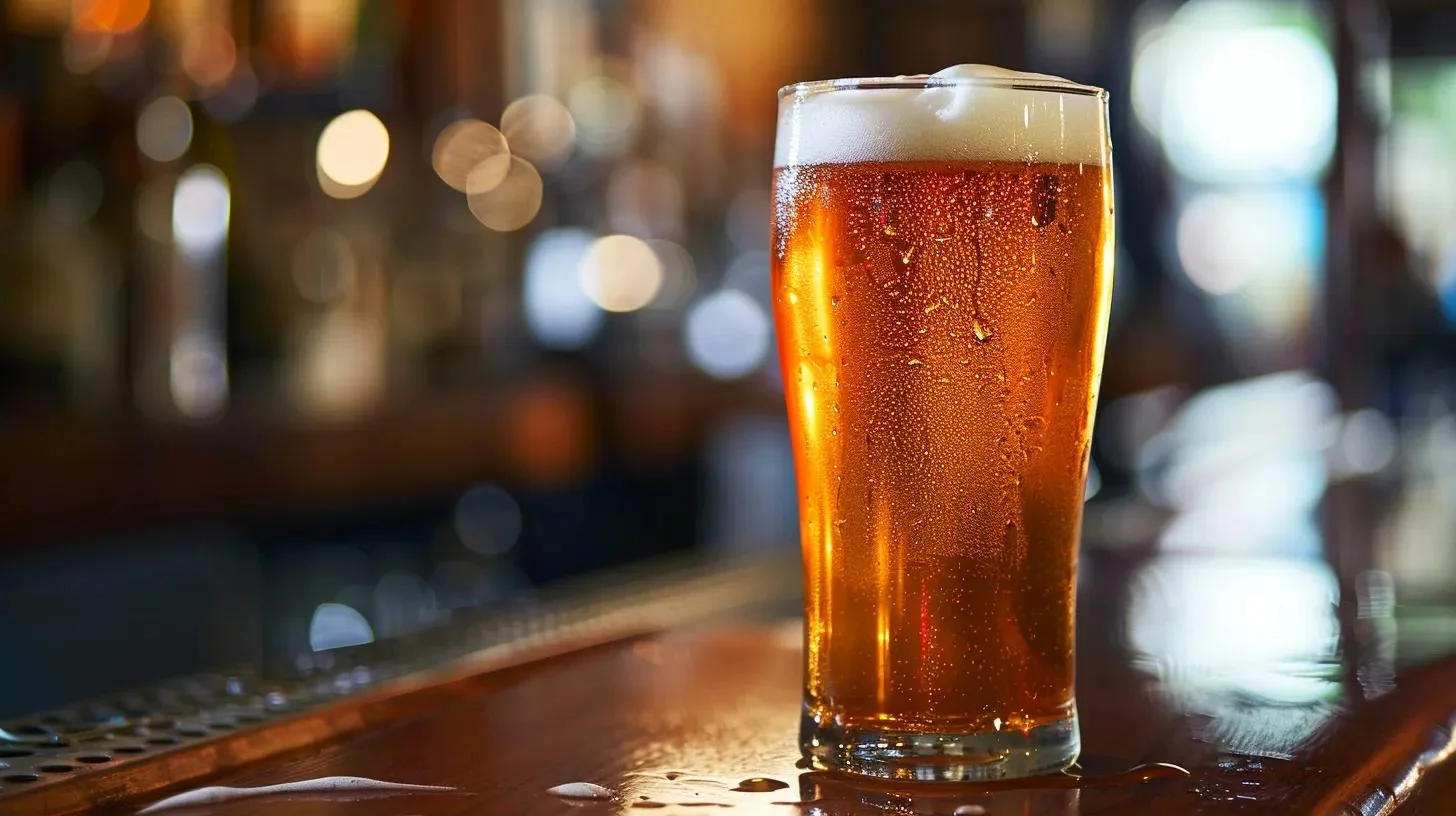How to Avoid Stale Beer in a Draft Beer System: Ensuring Freshness Every Pour

Ensuring that beer remains fresh and flavorful is a primary concern for establishments that offer draft beer. The quality of draft beer can be compromised if it becomes stale. Stale beer can occur due to improper storage, inadequate maintenance, or issues within the draft beer system itself.
To avoid serving stale beer, it's important to understand the components of draft beer systems and the role they play in preserving beer freshness. Proper maintenance of these systems is crucial. It involves regular cleaning, monitoring temperature and pressure, and understanding how to troubleshoot common issues that can affect beer quality.
Let's look at how to make beer cans and ensure draft beer stays fresh and flavorful with the following tips.
Understanding Draft Beer Systems
To ensure your draft beer maintains its ideal taste and freshness, it's important to understand the key components of draft beer systems and the types available. This understanding helps prevent stale beer by maintaining optimal conditions for serving.

Key Components
Draft Beer Equipment: The heart of any draft beer system is comprised of several essential components, each playing a critical role in beer dispensing:
- Keg: A container, typically made of stainless steel, holds the beer.
- Keg Coupler: This device attaches to the keg, connecting it to the beer line.
- Beer Lines: Tubes, often made of vinyl or polyethylene, carry beer from the keg to the faucet.
- Draft Tower: The most visible part of the system, where the faucet is mounted. and beer is dispensed.
- Faucets: The tap where beer is dispensed into glasses.
- CO2 or Nitrogen Tank: Provides the pressure needed for pushing beer out of the keg through the lines.
- Regulator: Manages the pressure from the gas tank to ensure consistent and appropriate dispensing pressure.
A well-maintained system ensures that draft beer is served at the right pressure and temperature, which is crucial for avoiding stale flavors.
Types of Draft Systems
Two common systems are used to serve draft beer, each tailored to different serving environments:
- Direct Draw System: Usually found in kegerators or smaller bar setups, this system dispenses beer directly from the keg, which is stored in a refrigerated cabinet beneath the faucet. It's a simple and effective system ideal for short distances between the keg and the faucet.
- Glycol System: Designed for long-distance beer dispensing, typically more than 25 feet, the Glycol Cooled Remote Beer System (Long-Draw) relies on a mixture of glycol and water to maintain a cool temperature through insulated beer lines from the keg to the tap.
A glycol system is effective for larger establishments where the kegs make beer is stored far from the serving area. Meanwhile, the direct draw system is more suited for settings where the keg is close to the serving point, ensuring minimal temperature rise and pressure loss.
Maintaining Ideal Serving Conditions
To prevent stale beer, it is essential to meticulously manage the serving conditions of a draft beer system. Precise temperature and pressure settings, as well as keen monitoring of carbonation levels, play pivotal roles in maintaining the freshness and quality of beer.
Temperature and Pressure Settings
The optimal temperature range for storing and serving kegged beer is between 38-40°F. This helps in preserving the flavor and reducing excessive foam. Equally important just beer itself is maintaining the correct pressure.

The psi (pounds per square inch) should typically be set between 10-12 psi to ensure a consistent flow and to keep the carbon dioxide from either over-carbonating own beer or under-carbonating the beer.
Monitoring Carbonation Levels
Maintaining the right level of carbonation is critical. Carbonation in beer is a balancing act where the amount of dissolved carbon dioxide needs constant monitoring.
Serving beer with either too much or too little carbonation can severely affect the taste and texture of alcohol. Beer that is either flat or overly fizzy is often a sign of incorrect carbonation levels, which can be adjusted by fine-tuning the system's temperature control and psi settings.
Regular Cleaning and Sanitization
Maintaining the quality and taste of draft beer requires an uncompromising approach to cleaning and sanitization. A meticulous cleaning schedule and the correct use of cleaning solutions are pivotal to preventing stale beer and ensuring the integrity of beer's taste and the draft beer experience.
Cleaning Schedule
A consistent cleaning schedule is critical for the upkeep of a draft beer system. Lines should be cleaned at least every two weeks to avoid the buildup of yeast, bacteria, and beer stone which can contribute to off-flavors and degrade the quality of the beer.
- Weekly tasks: Inspect and brush clean the faucets and couplers.
- Bi-weekly tasks: Flush the lines with a specialized beer line cleaning solution.
- Monthly tasks: Clean all kegs, including the keg coupler parts.
Proper Use of Cleaning Solutions
The effectiveness of routine cleaning hinges on the proper use of cleaning solutions. Operators must utilize cleaning solutions specifically designed for beer line systems. These are engineered to not only clean but also sanitize the lines. Regular water simply cannot remove all the organic deposits that accumulate within the system.
Most solutions require circulation through the lines for a set amount of time to achieve optimal results. To use them effectively, follow the manufacturer’s guidelines for dilution ratios to ensure efficacy. Then, allow the solution enough time to effectively break down and remove buildup. After cleaning, rinse the lines thoroughly with cold water to remove any traces of the cleaning agent.
Troubleshooting Common Issues
Properly maintaining a draft beer system is essential in avoiding stale or spoiled beer, excessive foaming, and the presence of off-flavors. The following subsections provide specific strategies for addressing these common issues.
Avoiding and Managing Foaming
Foam in draft beer systems is primarily linked to temperature and pressure inconsistencies. To avoid wasted beer due to excessive foaming, operators should ensure that their beer is stored at a consistent 36-38°F.
If foaming occurs, checking the CO2 pressure is critical. It should typically be between 10-14 PSI for most beers. Regular cleaning of the lines can also prevent contamination, another culprit for foaming problems.
For a detailed look at managing these aspects, read Troubleshooting Common Draft Beer System Problems: A Comprehensive Guide.
Detecting and Rectifying Off-Flavors
Off-flavors in beer can be indicative of just a day of bacterial contamination or line impurities. Regular cleaning schedules are crucial for preventing undesirable tastes.

It's recommended to clean beer lines every two weeks to eliminate the risk of bacterial build-up. Additionally, paying attention to beer's expiration dates and ensuring a proper serving temperature can help mitigate the risk of off-flavors developing.
For more maintenance tips, you can also check out Beer System Maintenance Tips: Cheers to The Perfect Pour.
Advanced Draft Beer System Considerations
Ensuring beer freshness and optimal taste requires meticulous control and understanding of the draft beer system's mechanics. The two critical areas that need focused attention are the balance of line length and diameter, and the optimization of flow rate and pressure.

Balancing Line Length and Diameter
Line length and diameter are pivotal in maintaining the correct resistance within your draft beer system. Too little resistance and beer can pour too quickly, leading to foam; too much resistance and it becomes flat beer pours too slowly.
A standard rule is to aim for 2-3 lbs of resistance per foot of beer line using 3/16-inch inside diameter lines. For direct draw systems, a 5-6 foot length is often sufficient. For longer runs, consult a comprehensive breakdown to ensure adequate balancing.

Optimizing Flow Rate and Pressure
Proper flow rate and pressure help avoid stale beer by maintaining the correct levels of carbonation.
Nitrogen and CO2 pressure should be regulated with a primary regulator attached to the gas cylinder. Optionally, a secondary regulator for precise control at the point of delivery is recommended.
A suitable gas blend and proper PSI settings are crucial. An ideal flow rate is about 1 ounce per second, corresponding to a pint in 15 seconds.
Regular maintenance of the regulators and lines can prevent pressure discrepancies that lead to staleness.
For more details, check out the following tips on regulating gas pressure:
- CO2 Systems: PSI settings typically between 12-14 PSI.
- Nitrogen Systems (Stout): PSI often starts around 30 PSI due to different solubility and pressure needs.
Frequently Asked Questions
Maintaining the freshness of beer in draft systems is crucial to ensure quality and taste. This section answers common queries related to keeping draft beer at its best.
What steps can be taken to maintain freshness in a draft beer system?
Regular cleaning of all components, including faucets, tap handles, and lines, is vital for maintaining beer freshness. Using specialized cleaning chemicals and tools can prevent the buildup of yeasts and bacteria that spoil the beer's taste and quality.

What are the common symptoms of dirty beer lines in a draft system?
Symptoms of dirty beer lines can include off-flavors, such as a musty or sour taste, and unusual foaminess or residue in the beer. If you find stale beer is not tasting as it should, it's a signal that the lines may need attention.
How can one ensure draft beer remains carbonated and does not become flat?
Maintaining the correct temperature and pressure is essential for preserving carbonation in a draft beer system. Regular checks and adjustments ensure that beer is dispensed with the proper level of carbonation.
What methods are effective at preserving the quality of draft beer over time?
To keep draft beer quality high, the keg and line system should be kept at a steady temperature. Also, the beer should be dispensed in a timely manner. Utilizing a glycol system helps maintain the required low temperatures for optimal beer conditions.
What might cause a draft beer to appear cloudy and how can it be remedied?
Cloudy beer can be due to yeast or protein suspensions. This may indicate that the beer is too warm or the lines are contaminated. Proper cleaning and storage warm beer at the right temperature can resolve and prevent cloudiness in draft beer.
Can dirty beer lines impact your health, and how might one recognize this?
Dirty beer lines are primarily a quality concern, but they can pose a health risk if bacteria are present. Symptoms that suggest this could include gastrointestinal distress following beer consumption. Ensuring regular and thorough cleaning of the beer system is key to preventing these issues.
Summary
Maintaining fresh, high-quality draft beer requires diligence in system maintenance.
- Temperature Regulation: The beer should be stored at consistently around 38°F to ensure optimal carbonation and prevent bacterial growth.
- Line Cleaning: Beer lines must be cleaned after every ½ keg or every two weeks to prevent buildup of yeast, bacteria, and beer stone.
- Water Quality: Hard water can lead to mineral deposits in the lines, making frequent cleaning necessary.
- Pressure Settings: Correct pressure maintains carbonation levels and prevents beer from becoming flat or overly foamy.
- System Balance: The resistance in the beer lines should match the applied pressure to ensure a perfect pour every time.
Adhering to a routine maintenance schedule is crucial for serving fresh beer and extending the lifespan of the draft system.
For detailed advice and products for maintaining draft systems, one might explore the offerings at Renny's Draft Solutions.



